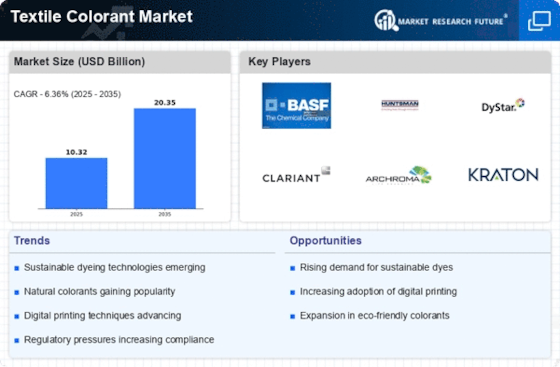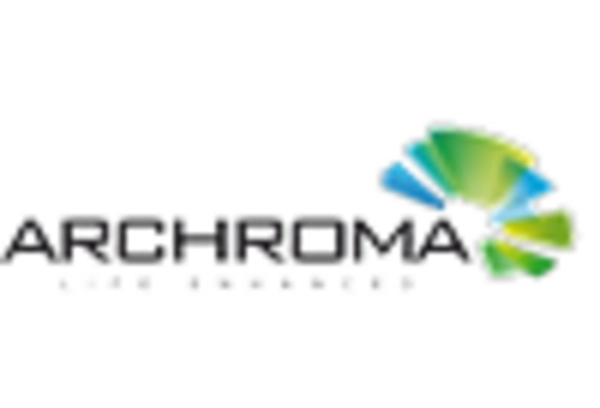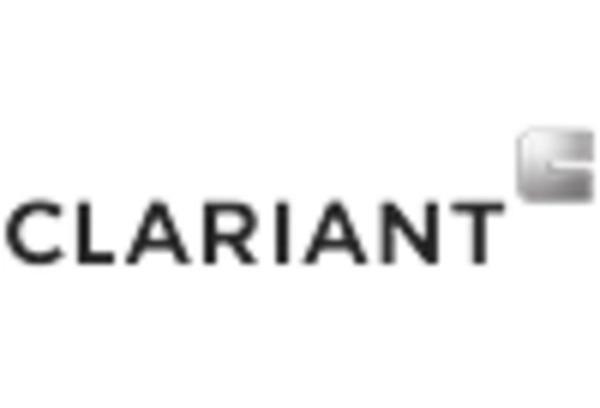Emerging Markets
Emerging markets are presenting new opportunities for growth within the Textile Colorant Market. As economies develop, there is an increasing demand for textiles, which in turn drives the need for colorants. Countries in Asia and Africa are witnessing a surge in textile production, fueled by rising disposable incomes and changing consumer preferences. This trend is likely to result in a substantial increase in the consumption of textile colorants, with projections indicating a growth rate of around 5% annually in these regions. Companies that strategically position themselves in these emerging markets may benefit from enhanced market share and profitability in the Textile Colorant Market.
Customization Trends
The rising trend of customization in the Textile Colorant Market is reshaping consumer expectations. As consumers seek unique and personalized products, manufacturers are responding by offering tailored color solutions. This shift is particularly evident in the fashion and home textiles sectors, where bespoke color options are becoming increasingly popular. The market for customized textile colorants is anticipated to expand significantly, driven by the desire for individuality and self-expression. Companies that can provide flexible color matching and rapid turnaround times are likely to gain a competitive edge. This trend underscores the importance of adaptability within the Textile Colorant Market.
Regulatory Compliance
Regulatory frameworks governing the use of chemical substances in textiles are becoming more stringent, impacting the Textile Colorant Market. Compliance with regulations such as REACH and GHS is essential for manufacturers to ensure product safety and environmental protection. These regulations are pushing companies to invest in safer, non-toxic colorants and to adopt sustainable practices. The market for compliant textile colorants is expected to grow as brands prioritize transparency and safety in their supply chains. This shift not only enhances consumer trust but also aligns with the broader movement towards responsible manufacturing within the Textile Colorant Market.
Technological Innovations
Technological advancements are playing a pivotal role in shaping the Textile Colorant Market. Innovations such as digital printing and advanced dyeing techniques are enhancing efficiency and reducing waste. For instance, digital textile printing allows for precise color application, minimizing excess dye usage and enabling rapid prototyping. The market for digital textile printing is expected to grow at a compound annual growth rate of over 20% in the coming years. Furthermore, the integration of artificial intelligence and automation in dyeing processes is streamlining operations and improving color consistency. These technological developments not only enhance productivity but also cater to the increasing demand for customized textile solutions.
Sustainability Initiatives
The increasing emphasis on sustainability within the Textile Colorant Market is driving demand for eco-friendly dyes and pigments. Consumers and manufacturers alike are becoming more aware of the environmental impact of traditional colorants, leading to a shift towards natural and biodegradable alternatives. This trend is reflected in the growing market for sustainable textile colorants, which is projected to reach a value of approximately USD 3 billion by 2026. Companies are investing in research and development to create innovative solutions that minimize water usage and reduce harmful emissions. As regulations tighten and consumer preferences evolve, the Textile Colorant Market is likely to see a significant transformation towards greener practices.

















